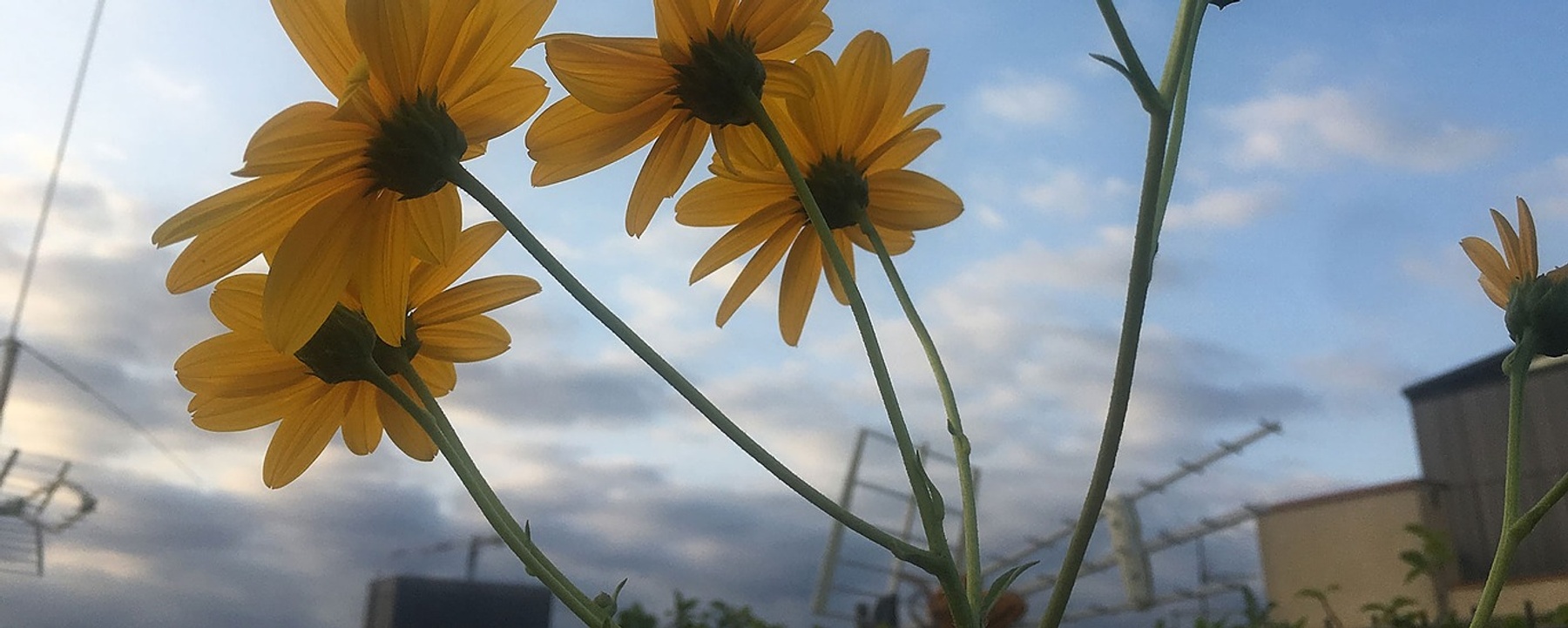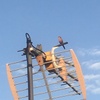
Red beaked visitor
Birding on the roof
Away all weekend, how I missed writing! And this morning when I went up to the garden, I had a surprise: a very small bird with a red beak sitting on the grape vine. I knew I couldn't get my camera out without it flying away so I just concentrated on looking at it. I saw the magpie eating grapes the other day, but now I suspect there may be others taking advantage of the bounty. Once it flew away, I finished going up the stairs and tried to find out what it was on my phone. And then it came back! This time in the loquat tree. Loquats are these little orange fruits that my daughter (who the tree belongs to) says are a cross between strawberries and oranges. They have big shiny beautiful seeds that grow by themselves in my compost pile, some of which I have transplanted and which are growing happily in pots. The tree gives a lot of fruit but this was the first time I had seen a bird in it. This time I had my phone in my hand, but even as I switched to my phone app, it flew away.
Red beak, reddish breast on a white background. Grayish plumage. Google, and a brilliant bird-illustrator friend say maybe a common waxbill (estrilda astrild), but I'm not convinced because my bird doesn't have a red mask, and it sings differently. Can you help? The third time it came back it sat up in the antenna and I surreptitiously got a few shots. And listened to its song: which I feel like an idiot for not having recorded, even if it were just me trying to copy it. Nightie, my black cat, must be getting old because he didn't even twitch.
I've never been a birder. It seems impossible to recognize a bird in flight and my eyes aren't good enough to see them far away. My cats generally keep them from getting close enough for a photo. The other birds that I love to watch from the garden are swifts, who do honor to their name. But it's not just speed that defines them, you can tell that they love flying. They fly so close overhead that you think you could reach out an arm to touch them. Books say they're looking for mosquitos but I think they're racing, and chasing, and probably laughing out loud with delight. I have filled up my phone many times with photos of blue evening sky and the edge of a tail of a passing swift. This summer I got one photo—by randomly shooting dozens of times into the sky into their flight path—that made me happy. (Note that swifts are not swallows, though they too go away in the winter and then return with the spring.)
I also get pigeons, are mourning doves, and seagulls passing by, once in a while making a tentative stop.
All the remaining grapes that I rescued from the magpie are gone, even the dried up ones. I'd take a bet on any of my winged friends.
I'm thinking of putting out a bird feeder, perhaps hanging it on one of the obsolete antennas that outline my roof. Who else might come? And will they eat some of the caterpillars and larva??
The pumpkin seems very happy. New male flowers come and go, but I haven't seen a single female one since the pumpkin started to develop. Tomorrow I'll tell you about my other flying visitors: the dragonflies. Subscribe to get updates in your mailbox, plus seeds and other treats.
P.S. The consensus on Twitter is that it really is a common waxbill. I'm going to see if I can get a better photo to prove it. Thanks to Pere Alzina and the others who answered my calls for help. He also recommended the Catalan Ornithological Information Service Servidor d'informació ornitològica de Catalunya, important state infrastructure if ever there was any.
And what is an exotic African bird doing in Barcelona? They were domesticated animals and escaped from their cages about ten years ago and now there are about 3000 of them living in and around Barcelona. There is a long tradition of people having exotic birds in cages here, and also of them escaping and living in the wild: particularly big green parrots, which are now considered a health hazard but that is a post for another day, and I have yet to get visits from them!
Red beak, reddish breast on a white background. Grayish plumage. Google, and a brilliant bird-illustrator friend say maybe a common waxbill (estrilda astrild), but I'm not convinced because my bird doesn't have a red mask, and it sings differently. Can you help? The third time it came back it sat up in the antenna and I surreptitiously got a few shots. And listened to its song: which I feel like an idiot for not having recorded, even if it were just me trying to copy it. Nightie, my black cat, must be getting old because he didn't even twitch.
I've never been a birder. It seems impossible to recognize a bird in flight and my eyes aren't good enough to see them far away. My cats generally keep them from getting close enough for a photo. The other birds that I love to watch from the garden are swifts, who do honor to their name. But it's not just speed that defines them, you can tell that they love flying. They fly so close overhead that you think you could reach out an arm to touch them. Books say they're looking for mosquitos but I think they're racing, and chasing, and probably laughing out loud with delight. I have filled up my phone many times with photos of blue evening sky and the edge of a tail of a passing swift. This summer I got one photo—by randomly shooting dozens of times into the sky into their flight path—that made me happy. (Note that swifts are not swallows, though they too go away in the winter and then return with the spring.)
I also get pigeons, are mourning doves, and seagulls passing by, once in a while making a tentative stop.
All the remaining grapes that I rescued from the magpie are gone, even the dried up ones. I'd take a bet on any of my winged friends.
I'm thinking of putting out a bird feeder, perhaps hanging it on one of the obsolete antennas that outline my roof. Who else might come? And will they eat some of the caterpillars and larva??
The pumpkin seems very happy. New male flowers come and go, but I haven't seen a single female one since the pumpkin started to develop. Tomorrow I'll tell you about my other flying visitors: the dragonflies. Subscribe to get updates in your mailbox, plus seeds and other treats.
P.S. The consensus on Twitter is that it really is a common waxbill. I'm going to see if I can get a better photo to prove it. Thanks to Pere Alzina and the others who answered my calls for help. He also recommended the Catalan Ornithological Information Service Servidor d'informació ornitològica de Catalunya, important state infrastructure if ever there was any.
And what is an exotic African bird doing in Barcelona? They were domesticated animals and escaped from their cages about ten years ago and now there are about 3000 of them living in and around Barcelona. There is a long tradition of people having exotic birds in cages here, and also of them escaping and living in the wild: particularly big green parrots, which are now considered a health hazard but that is a post for another day, and I have yet to get visits from them!




Write a comment
Log in with your account or sign up to add your comment.